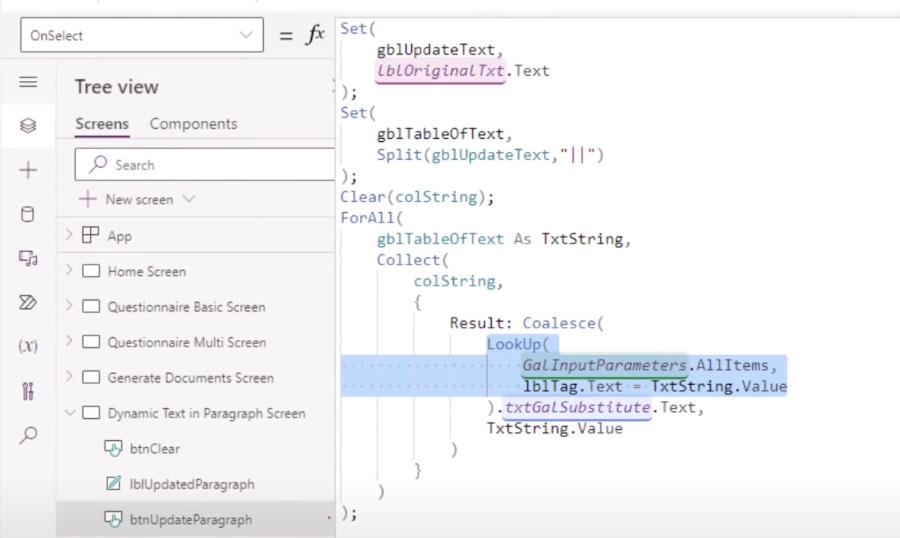
Maximize Power Apps with Dynamic Text for Docs & Prompts
Power Platform Cloud Solutions Architect @ Microsoft | Microsoft BizApps MVP 2023 | Power Platform | SharePoint | Teams
Master Dynamic Text Strings in Power Apps for Enhanced Document Customization #PowerApps
Key insights
Dynamic String Customization in Power Apps: Power Apps offers innovative methods for creating dynamic text strings, useful for customizing documents or emails. Through placeholders and automatic information filling, Power Apps enables dynamic prompts and content customization, enhancing document personalization.
- Using the $ function simplifies dynamic string formatting, allowing variables and expressions within strings, and improving code readability and efficiency.
- Power Apps supports dynamic string creation through multiple methods including concatenation, the Concatenate function, and variables. These facilitate personalized UIs and dynamic data handling.
- Named functions in Power Apps, although in preview, offer code reusability and maintainability without storing values, recalculating for up-to-date results.
- Best practices highlight the importance of code readability, the use of comments for complex logic, and thorough testing to ensure dynamic text is displayed correctly.
- Power Apps' dynamic strings and functions provide enhanced user personalization and efficiency, however, it's crucial to consider the experimental status of named functions and their limitations in production environments.
Deep Dive into Dynamic Text Strings in Power Apps
Power Apps stands out as a versatile tool for building business applications with custom user interfaces. One of the platform’s strong suits is its capability to manage dynamic text strings efficiently. This feature proves incredibly beneficial for developers and designers aiming to produce highly personalized and interactive applications. The dynamic customization extends to various elements like documents, emails, and user interfaces, allowing texts to adapt based on user actions or data inputs.
For Power Apps users and developers, mastering dynamic string manipulation and keeping abreast of new features like named functions can significantly enhance the flexibility and functionality of their applications. It not only aids in creating more engaging user experiences but also underscores the importance of adopting best practices in code organization, testing, and maintenance for optimal app performance.
In summary, as Power Apps continues to evolve, its dynamic text string capabilities and the introduction of features like named functions highlight the platform's commitment to providing powerful tools that cater to the complex needs of modern application development. These advancements promise to make app customization and personalization even more accessible and efficient for developers across the Power Platform ecosystem.

In this YouTube video, Damien Bird [MVP] introduces an intriguing method for handling dynamic text strings within Power Apps, specifically aimed at simplifying the customization of paragraphs in documents or emails. He explains a technique using placeholders to design text boxes, which then automatically populate with the required data, adjusting dynamically to the user's needs. This trick proves particularly beneficial for similar applications like GPT prompts or adding customizable content to documents, paving the way for more dynamic and user-friendly document creation processes.
Further into the video, Damien explores Power Apps' $ function, a recent addition that significantly streamlines string formatting by allowing direct embedding of variables and expressions within strings, doing away with the need for lengthy concatenation methods. Employing examples, he demonstrates how this function can craft comprehensive strings that integrate user information or utilize conditional logic, presenting a clean, efficient way to handle complex strings with dynamic components.
Additionally, Damien provides a step-by-step guide on using dynamic text strings in Power Apps using both basic concatenation and the Concatenate function, alongside implementing variables and managing complex data references. He emphasizes the importance of readability and maintainability in code, advising on best practices like utilizing comments and testing thoroughly to ensure dynamic text operates correctly across various scenarios. His explanation sheds light on creating personalized user interfaces, displaying messages based on user input, and effectively handling data within applications.
The concept of named functions, currently an experimental feature in Power Apps, is also discussed. Damien outlines the benefits such as code reusability, maintainability, potential performance improvements, and enhanced clarity in coding complex formulas. Though he cautions about their experimental status and the absence of parameter acceptance, the segment serves as an insightful exploration into elevating app design through advanced functionality and named formulas.
Culminating his presentation, Damien touches on resource materials and further readings, though ensuring to keep the focus strictly educational by excluding any external links to social media or promotional content. Through a detailed yet comprehensible walkthrough, this video serves as an invaluable resource for developers looking to enhance their understanding and application of dynamic text strings in Power Apps.

## Questions and Answers about Power Platform/Power Automate
Keywords
PowerApps Dynamic Text, PowerApps Documents, Dynamic Text Strings, PowerApps Prompts, PowerApps Paragraphs, Dynamic Documents PowerApps, PowerApps Text Manipulation, Custom Text PowerApps, PowerApps Document Generation, Text String Handling PowerApps